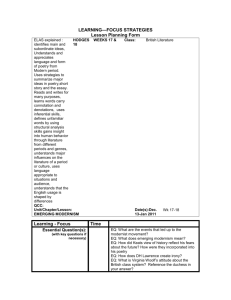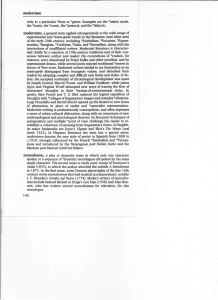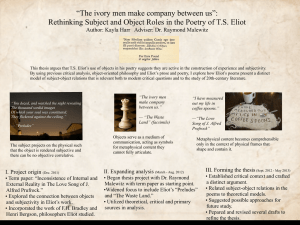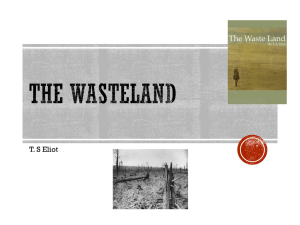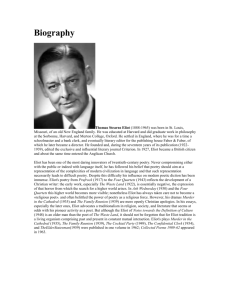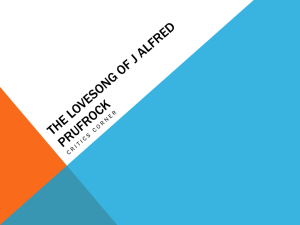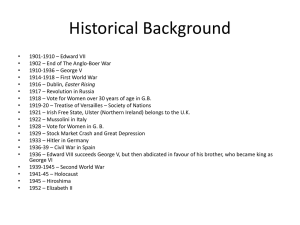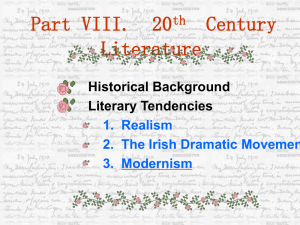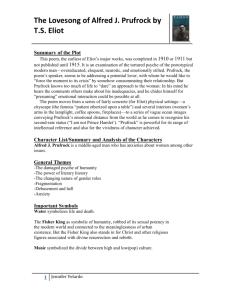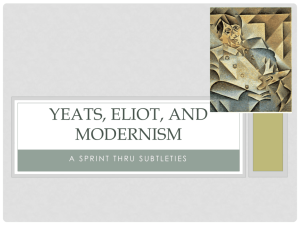Modernism - marilena beltramini
advertisement
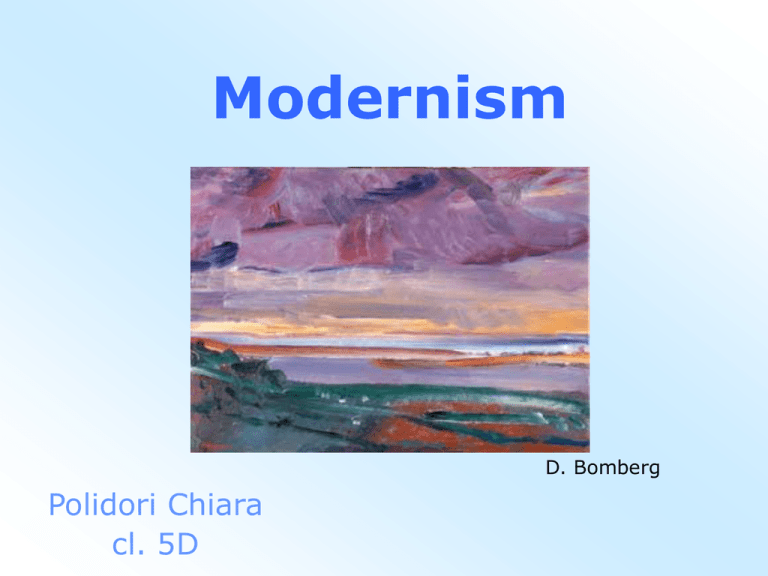
Modernism D. Bomberg Polidori Chiara cl. 5D What is Modernism? • It is a cultural trend. • It is the movement in visual arts, music, literature and drama which rejected the old Victorian standars of how art should be made and consumed. Period of Time It developed in the first three decades of the 20th century. Location It developed in Europe, expecially in the Great Britain. Features Poetry Modernism Drama Fiction Exponents Poetry Modernism Drama Fiction The End Modernism was very important in Europe because it “founded” Postmodernist movement, which developed in the second half of the 20th century. Wyndham Lewis Poetry • T.S.Eliot • E.Pound • W.B.Yeats Fiction • James Joyce • Virginia Woolf Thomas Stearns Eliot He was a poet, dramatist and literary critic. He received the Nobel Prize in Literature in 1948. He is considered the most important modernist exponent in poetry. Eliot’s Main Important Poems • “The Love Song of J.A.Prufrock • “The Waste Land” Ezra Pound He was an American expatriate poet and critic. He was a major figure of Modernist movement, notably Imagism and Vorticism. William Butler Yeats He was an Irish poet and dramatist. In 1923 he adwarded a Nobel prize in Literature. He was a very important Modernist poet. Features in Poetry • • • • • • Intertestuality Objective Correlative Mythical Method Cosmopolitan nature Space and Time’s references Dramatic Monologue Features in Fiction • • • • The The The The Stream of Consciousness Inner Monologue Shifting of the Point of View Third-Person Narrator Voice Features in Drama • The social theatre of G.B.Shaw • The continuation of the traditional Comedy of Manners • The importance of Irish drama production The Love Song of J.A.Prufrock It is a dramatic monologue where the protagonist speaks with his consciousness about his inner problems. Key Words Key Words • Time: Prufrock has an unhappy relation with time. It creates confusion in his mind. • Space: Prufrock is imprisoned in an opaque sphere, that is his consciousness. • Epigraph: is the quotation of Dante’s Inferno. It closes and opens the discourse of a poet-hero. • Objective Correlative:is a method used by Eliot in his poems. Here it is used to express the inability of men to act and the vulgarity of society. The Waste Land It is the most important poem of T.S.Eliot. It is read as a representation of the disillusionment of the post-war generation. It is a long poem: it consists of 5 parts: “The Burial of the Dead”, “A Game of Chess”, “The Fire Sermon”, “Death by Water” and “What the Thunder Said”. Key Words Key Words • Verbs: the use of present participle recalls the idea of continuity. • Fragmentation: Eliot uses German words to create a relation between two cultures. Moreover he uses quotations by other poets. • Mhytical Method: is important because it gives a meaning to the panorama of futility. • Intertestuality: Eliot adopts references of Chaucer, Dante and Baudelaire. • Pessimism: the situation of modern man in a city is the same nowadays. James Joyce J.Joyce was an Irish expatriate writer. He is best known for his novel Ulysses and his famous collection of short stories, that is Dubliners. Ulysses The novel is the most important work of Joyce: it is a modern interpretation of the Odyssey. The Stream of Consciousness The Shifting of the Point of View Dubliners It is a collection of short stories, written in 1914. It tells about people who are timid and conformist. Setting Techniques The city of Dublin The Stream of Consciousness Narrator The third person narrator Virginia Woolf She was a very important modernist english novelist. Her famous works include the novels “Mrs Dalloway” and “To the Lighthouse”.
